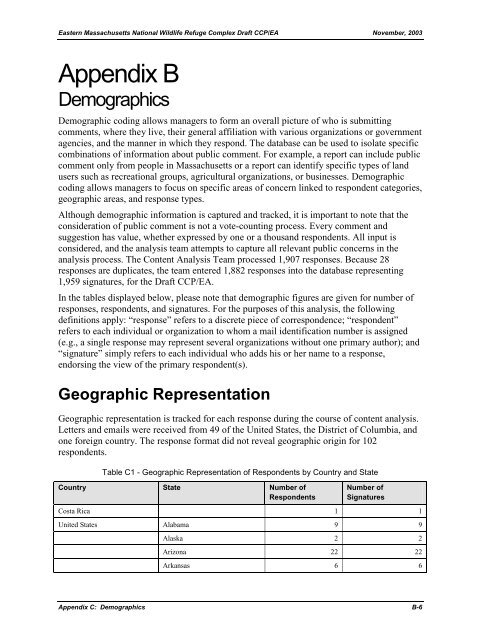Assabet River NWR Final CCP - U.S. Fish and Wildlife Service
Assabet River NWR Final CCP - U.S. Fish and Wildlife Service
Assabet River NWR Final CCP - U.S. Fish and Wildlife Service
You also want an ePaper? Increase the reach of your titles
YUMPU automatically turns print PDFs into web optimized ePapers that Google loves.
Eastern Massachusetts National <strong>Wildlife</strong> Refuge Complex Draft <strong>CCP</strong>/EA November, 2003<br />
Appendix B<br />
Demographics<br />
Demographic coding allows managers to form an overall picture of who is submitting<br />
comments, where they live, their general affiliation with various organizations or government<br />
agencies, <strong>and</strong> the manner in which they respond. The database can be used to isolate specific<br />
combinations of information about public comment. For example, a report can include public<br />
comment only from people in Massachusetts or a report can identify specific types of l<strong>and</strong><br />
users such as recreational groups, agricultural organizations, or businesses. Demographic<br />
coding allows managers to focus on specific areas of concern linked to respondent categories,<br />
geographic areas, <strong>and</strong> response types.<br />
Although demographic information is captured <strong>and</strong> tracked, it is important to note that the<br />
consideration of public comment is not a vote-counting process. Every comment <strong>and</strong><br />
suggestion has value, whether expressed by one or a thous<strong>and</strong> respondents. All input is<br />
considered, <strong>and</strong> the analysis team attempts to capture all relevant public concerns in the<br />
analysis process. The Content Analysis Team processed 1,907 responses. Because 28<br />
responses are duplicates, the team entered 1,882 responses into the database representing<br />
1,959 signatures, for the Draft <strong>CCP</strong>/EA.<br />
In the tables displayed below, please note that demographic figures are given for number of<br />
responses, respondents, <strong>and</strong> signatures. For the purposes of this analysis, the following<br />
definitions apply: “response” refers to a discrete piece of correspondence; “respondent”<br />
refers to each individual or organization to whom a mail identification number is assigned<br />
(e.g., a single response may represent several organizations without one primary author); <strong>and</strong><br />
“signature” simply refers to each individual who adds his or her name to a response,<br />
endorsing the view of the primary respondent(s).<br />
Geographic Representation<br />
Geographic representation is tracked for each response during the course of content analysis.<br />
Letters <strong>and</strong> emails were received from 49 of the United States, the District of Columbia, <strong>and</strong><br />
one foreign country. The response format did not reveal geographic origin for 102<br />
respondents.<br />
Table C1 - Geographic Representation of Respondents by Country <strong>and</strong> State<br />
Country State Number of<br />
Respondents<br />
Number of<br />
Signatures<br />
Costa Rica 1 1<br />
United States Alabama 9 9<br />
Alaska 2 2<br />
Arizona 22 22<br />
Arkansas 6 6<br />
Appendix C: Demographics B-6

















